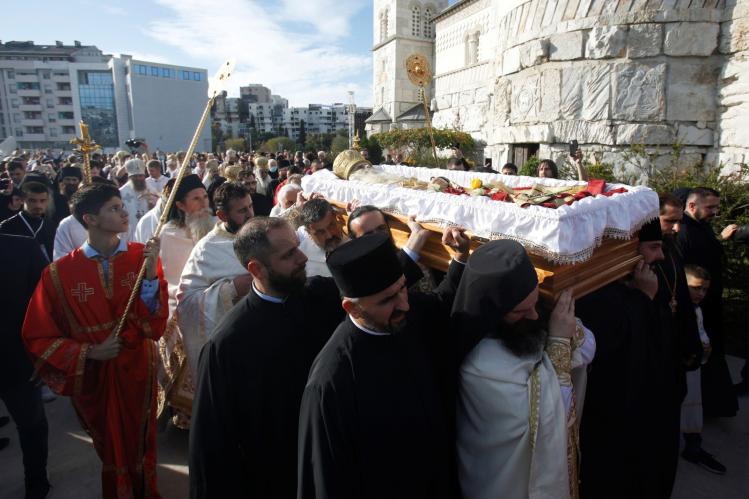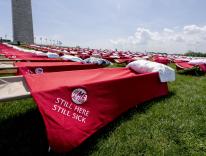
Depending on how you count, the Orthodox Christian Church has fourteen, fifteen, or sixteen autocephalous (i.e. self-governing) jurisdictions. To date, three of its autocephalous leaders—Irinej of Serbia, Ieronymos of Greece, and Anastasios of Albania—have been hospitalized with COVID-19; Irinej of Serbia died from it on November 20. At least a dozen Orthodox bishops have also died from the virus. Among the lower ranks of clergy, the numbers are even more alarming. In Russia, more than one hundred priests or monks have died.
Perhaps we should use these grim statistics to remind ourselves that the clergy often serve as “first responders” to the sick and suffering. In the age of COVID-19, a routine pastoral visit can carry genuine risk. Digging a little deeper into some of these cases, however, suggests that too many Orthodox clerics, bishops included, have acted as though they think they are immune to the virus.
Why? Have they wrongly extrapolated what they believe about the Eucharist to extend to their role as sacramental officiants? Do they naively think that God protects the clergy (or perhaps all “true” believers) from illness?
Let’s start with the case of the much-loved and respected Metropolitan Amfilohije (Radović) of Montenegro, who succumbed to COVID-19 on October 30. Prior to Patriarch Irinej’s death, Amfilohije was the most prominent Orthodox bishop to die from the pandemic. Amfilohije was also one of a dangerously large number of bishops who flouted social-distancing recommendations. Not only was he regularly seen in public without a mask, but he also suggested that large religious gatherings (such as a religious pilgrimage to the tomb of St. Vasilije Ostroski he attended in May) were “God’s vaccine.”
Patriarch Irinej presided over Amfilohije’s funeral on November 1. Thousands of mourners attended the crowded funeral. None of the clergy and few of the attendees wore masks during the long service. Nineteen days later, the patriarch died. Again, there were thousands of mourners, and again most of them ignored guidelines on masks and social distancing. Then, on December 4, the locum tenens of the Serbian Orthodox Church, the man entrusted to steer the Church through the election of a new patriarch, was himself hospitalized with COVID-19. It would be difficult to overstate the extent to which the virus has crippled the leadership of Serbian Orthodox Church.
The situation in Greece is only marginally better. To date, six of the nation’s eighty-two bishops have contracted the disease; one has died. Metropolitan Bishop Ioannis of Lagas, sixty-two, an outspoken critic of government efforts to curtail church services during the pandemic, died on November 15. The Episcopal Synod of the Church of Greece has been more willing than their Serbian counterparts in supporting government imposed, social-distancing restrictions. But there are, of course, those who publicly flout the guidelines. One priest in northern Greece urged parishioners to defy government restrictions, irresponsibly proclaiming “you’re either with Christ or the coronavirus.”
When the pandemic first became a global concern in the spring of 2020, the debate among public-health officials, church leaders, and theologians fixated around the question of whether or not the Eucharist might serve as a means for the dissemination of the virus.
Unlike the Roman Catholic Church, the Orthodox Church distributes both elements of the Eucharist with a common spoon. It has not always been done this way. But it has been this way for long enough (approximately one thousand years) that many faithful presume, as a contention of faith, that the distribution of the Eucharist does not and cannot spread disease.
In some corners of the Orthodox world, a few pastorally inclined bishops have encouraged the use of multiple single-use spoons rather than a common spoon. To my knowledge, no bishop publicly suggested that the reception of the Eucharist could spread the disease. Rather, leaders such as Archbishop Elpidophoros, the archbishop of the Greek Orthodox Church of America, presented the policy as a temporary concession to those who might wish to receive the sacrament but were reluctant to do so during the pandemic. Not surprisingly, that proposal sparked immediate condemnation from the super-pious, who saw the archbishop’s recommendation as tantamount to apostasy. While Elpidophoros had broad support among theologians and liturgical historians (there is, in fact, no dogmatic significance to the use of one or more spoons), none of the other forty-plus Orthodox bishops in the United States followed his lead. Similar proposals were adopted elsewhere—in various dioceses in Finland, Romania, and Ukraine—but the predominant practice in the Orthodox world has continued the use of a common spoon.
As the threat of the pandemic grew and governments around the world forcibly closed churches, the debate in Orthodox circles soon shifted from a question of whether or not the Eucharist could be a conduit for the spread of the disease to a series of questions regarding government injunctions and/or the possibility of participating in services through internet technology.
Metropolitan John Zizioulas, arguably the most acclaimed Orthodox theologian alive today, shocked a great number of people when he declared in an interview that while he supported the government’s decision to close the churches to lay people, he did not believe watching a televised liturgy was an acceptable substitute. “I will not turn the television on in order to watch the Liturgy. I consider that an expression of impiety. It is impious for someone to sit and watch the Liturgy.” He proposed, instead, that families read morning prayers together. But a good number of priests in the United States with significant online followings were exasperated by the metropolitan’s comments.
A few months ago, I received an email from a priest that I’ve known for decades. He declared that no one should ever wear a mask in church. For him, it was not enough that Christians affirm that the Eucharist is safe—it was necessary that they demonstrate their faith by disregarding any concern for the possibility that COVID-19 might spread from one worshipper to another during a service. We are being tested, he suggested; would we be counted as real believers or not?
It’s hard to know why some clerics and laity want to force the issue in this way. My suspicion is that the explanation lies in sociological or psychological analysis. Christian theology certainly does not explain this.
With infections rising, bishops dying, and nearly everyone feeling exhausted by the pandemic, it is unclear if anything will be different for the Orthodox Church prior to mass vaccination. But one thing has been obvious from the beginning: this virus does not discriminate between those who believe in Christ and those who do not. Most of the Orthodox Christian clergy understand this. They are taking prudent precautions while continuing the sacramental life of the Church as much as possible. I pray that the rest will follow suit, for the sake of us all.
Please email comments to [email protected] and join the conversation on our Facebook page.
Previous Story
Poem | Astronomy
Next Story
Poem | Ars Poetica

